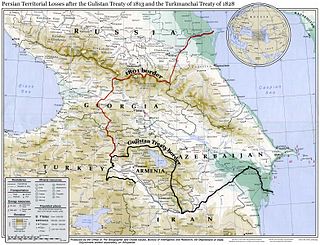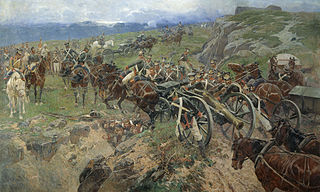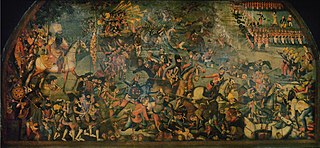
Abbas Mirza was the Qajar crown prince of Iran during the reign of his father Fath-Ali Shah Qajar. As governor of the vulnerable Azerbaijan province, he played a crucial part in the two wars against the Russian Empire, as well as the war of 1821–1823 against the Ottoman Empire. He is also recognized for leading Iran's first reform and modernization attempts with the help of his ministers Mirza Bozorg Qa'em-Maqam and Abol-Qasem Qa'em-Maqam.

The Treaty of Gulistan was a peace treaty concluded between the Russian Empire and Qajar Iran on 24 October 1813 in the village of Gulistan as a result of the first full-scale Russo-Persian War. The peace negotiations were precipitated by the successful storming of Lankaran by General Pyotr Kotlyarevsky on 1 January 1813. It was the first of a series of treaties signed between Qajar Iran and Imperial Russia that forced Persia to cede the territories that formerly were part of Iran.

Prince Alexander of Georgia was a Georgian royal prince (batonishvili) of the Bagrationi dynasty, who headed several insurrections against the Russian rule in Georgia. He was known as Eskandar Mīrzā (اسکندرمیرزا) in Persia, tsarevichAleksandr Irakliyevich in Russia, and Alexander Mirza in Western Europe.
The Russo-Persian Wars or Russo-Iranian Wars were a series of conflicts between 1651 and 1828, concerning Persia and the Russian Empire. Russia and Persia fought these wars over disputed governance of territories and countries in the Caucasus. The main territories disputed were Aran, Georgia and Armenia, as well as much of Dagestan – generally referred to as Transcaucasia – and considered part of the Safavid Iran prior to the Russo-Persian Wars. Over the course of the five Russo-Persian Wars, the governance of these regions transferred between the two empires. Between the Second and Third Russo-Persian Wars, there was an interbellum period in which a number of treaties were drawn up between the Russian and the Persian Empires, as well as between both parties and the Ottoman Empire. Ottoman interest in these territories further complicated the wars, with both sides forming alliances with the Ottoman Empire at different points throughout the wars. Following the Treaty of Turkmenchay, which concluded the Fifth Russo-Persian War, Persia ceded much of its Transcaucasian territory to the Russian Empire.

The Russo-Persian War of 1804–1813 was one of the many wars between the Persian Empire and Imperial Russia, and, like many of their other conflicts, began as a territorial dispute. The new Persian king, Fath Ali Shah Qajar, wanted to consolidate the northernmost reaches of his kingdom—modern-day Georgia—which had been annexed by Tsar Paul I several years after the Russo-Persian War of 1796. Like his Persian counterpart, the Tsar Alexander I was also new to the throne and equally determined to control the disputed territories.

Shirvan Khanate was a Caucasian khanate under Iranian suzerainty, which controlled the Shirvan region from 1761 to 1820.

The Nakhichevan Khanate was a khanate under Iranian suzerainty, which controlled the city of Nakhichevan and its surroundings from 1747 to 1828.

The Russo-Persian War of 1826–1828 was the last major military conflict between the Russian Empire and Qajar Iran, which was fought over territorial disputes in the South Caucasus region.

Hossein Qoli Khan Qajar Sardar Iravani was a statesman and commander in Qajar Iran, who was the last khan (governor) of the Erivan Khanate from 1807 to 1828.

Nader Shah Afshar was the founder of the Afsharid dynasty of Iran and one of the most powerful rulers in Iranian history, ruling as shah of Iran (Persia) from 1736 to 1747, when he was assassinated during a rebellion. He fought numerous campaigns throughout the Middle East, the Caucasus, Central Asia, and South Asia, such as the battles of Herat, Mihmandust, Murche-Khort, Kirkuk, Yeghevārd, Khyber Pass, Karnal, and Kars. Because of his military genius, some historians have described him as the Napoleon of Persia, the Sword of Persia, or the Second Alexander. Nader belonged to the Turkoman Afshars, one of the seven Qizilbash tribes that helped the Safavid dynasty establish their power in Iran.

Mirza Abolhassan Khan Ilchi was an Iranian politician and diplomat who served as the Minister of Foreign Affairs twice, first from 1824 to 1834, and then again from 1838 until his death in 1845. He also served as the ambassador to Russia and Britain, and was the main Iranian delegate at the signing of the Golestan and Turkmenchay treaties with Russia in 1813 and 1828 respectively.

Mirza Adigozal bey was an Azerbaijani historian of the 19th century, author of the Garabaghname. He studied at maktab, in Shusha. From the beginning of the 19th century, he was in the governmental and military-administrative service of Russia. He was captain of the Imperial Russian Army.

The province of Daghestan was a province of Safavid Iran, centred on the territory of the present-day Republic of Dagestan. Numerous high-ranking Safavid figures originally hailed from the province, or had roots there.
Mostafa Khan was the last khan of Shirvan, until 1820.

The siege of Erivan took place from July to September 1804, during the Russo-Persian War (1804–1813). After a difficult advance, the Russians under Pavel Tsitsianov besieged Erivan. The Iranian forces inside Erivan's citadel prevented the Russians from making a direct attack, while those outside the citadel surrounded the Russians and cut the invaders' supply lines. Commanded by Crown-Prince Abbas Mirza and King Fath-Ali Shah Qajar himself, the Iranians successfully defended the city and defeated the Russian attack. Tsitsianov, in order to save his reputation, shifted the blame on a plethora of people and matters, and deliberately left out his own wrongdoings.

The Battle of Echmiadzin took place in June 1804, during the Russo-Persian War of 1804–1813. A Russian force of 5,000 men under Pavel Tsitsianov advanced on Erivan. An Iranian army of 20,000 under Crown-Prince Abbas Mirza met him at Echmiadzin. Cutting off the Russian's supplies the Iranians successfully defended the town and forced the Russians to withdraw. Though the Russians were unable to capture Echmiadzin, the outcome of the battle itself has been variously described as inconclusive, an Iranian victory, or a Russian victory.

The Guarded Domains of Iran, commonly referred to as Afsharid Iran or the Afsharid Empire, was an Iranian empire established by the Turkoman Afshar tribe in Iran's north-eastern province of Khorasan, establishing the Afsharid dynasty that would rule over Iran during the mid-eighteenth century. The dynasty's founder, Nader Shah, was a successful military commander who deposed the last member of the Safavid dynasty in 1736, and proclaimed himself Shah.
Sargis II Hasan-Jalalyan was the last catholicos of Aghvank from 1810 to 1815.
Ughurlu Khan or Oghurlu Khan was a claimant to Khanate of Ganja and a member Ziyadoghlu Qajar, a clan of the Qajar tribe.
Sohrab Khan Gorji, was a commander who served the Persian army from 1822 to 1834, during the reign of Fath-Ali Shah Qajar. In 1832, Sohrab Khan became the governor of several Iranian cities. He was of Georgian origin; and in Iran he held the title Gholam-e Pishkhedmat-bashi.















